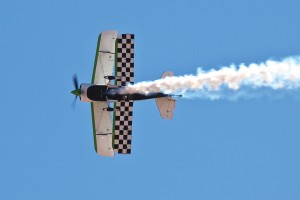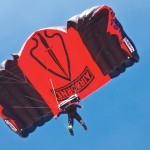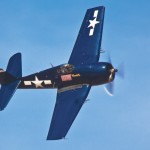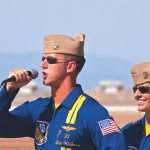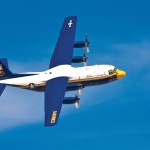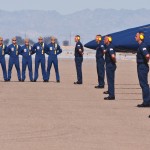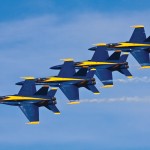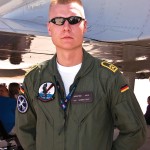By John Wright
The U.S. Navy flight demonstration team, The Blue Angels, opened their 2009 season with their traditional show at the Naval Air Facility, El Centro, on March 14. The annual show culminates
two months of training in the California desert before the team returns to their home at Naval Air Station, Pensacola, Fla.
Under the crystal clear skies of El Centro, show spectators from across the Imperial Valley were presented with numerous military and civilian displays and aerial demonstrations.
First to fly was a group of vintage Boeing Stearman PT-17s and N2S-1s. Private collectors Terry Emig of Casa Grande, Arz., Larry Dustman from Chandler, Arz., and Mike Hanson of Westminster, Calif., put on a demonstration of precision formation that flying fledgling pilots were taught in these same aircraft during World War II.
Since the end of the Cold War, large numbers of former Eastern Bloc aircraft have become available on the open market. More and more of these are showing up at air shows in the U.S. One group using these aircraft is the Thunder Delfins. The team, comprised of four former military pilots, flies the Czech Aero Vodochody L-29 Delfin (Czech for “dolphin”). The Delfin is a two-place trainer aircraft built in Czechoslovakia and used in virtually every Warsaw Pact Nation.
Veteran military and airline pilot Bill Cornick put on a spectacular aerobatic demonstration in his “Super” Pitts S-2C biplane. Partnered with Cornick was Spencer Suderman, another aerobatic pilot, flying the Meteor Pitts. He demonstrated some of his unique aerobatic maneuvers, including a double hammerhead, torque and roll tailslide, and the ever-impressive Lomcevak.
During the afternoon portion of the show, the duo flew in the first-ever of the Aerobatic Racing Challenge, California series. This is a race in which the pilots perform side-by-side aerobatic maneuvers, and the first pilot to finish is the winner.
One of the most popular acts touring the southern California airshow circuit is John Collver and his SNJ “War Dog.” Collver demonstrates the type of maneuvers pilots were taught during advanced training. The SNJ/AT-6 aircraft was the last step before a pilot was sent to fighters or bombers.
The “Longhorns” of Naval Air Station Fallon, a Navy search and rescue team based at NAS Fallon, Nev., are responsible for providing SAR capabilities to the sprawling Fallon Range training complex. The team is the last Navy unit to operate the venerable HH-1N “Huey” helicopter and covers all of northern Nevada and much of northern California, including the Sierra Nevada mountains from Lake Tahoe to south of Yosemite National Park.
The team demonstrated the HH-1N’s capability of placing a Hospital Corps man on the ground to assist a victim and then recovering both people on the aircraft hoist while transitioning from a hover to forward flight.
U.S. Air Force Capt. Phil Smith (pilot) and Capt. John Cox (weapons officer) of Air Combat Command displayed the air-to-air and air-to-ground capabilities of the dual-role F-15E Strike Eagle.
Essential to the capabilities of the U.S. Navy and U.S. Air Force are the numerous aircraft used to support combat operations around the globe.

The U.S. Air Force’s Air Combat Command F-15E demonstration team—comprised of Capt. Phil “Ritz” Smith (pilot) and Capt. John “Gizmo” Cox (weapons officer)— demonstrated the low-level attack capabilities of the F-15E Strike Eagle.
The Grumman C-2 Greyhound is a Carrier Onboard Delivery (COD) aircraft used for transporting personnel and cargo between shore and the carrier. A C-2 of Fleet Logistic Support Squadron Three Zero (VRC-30) based at NAS North Island in San Diego, made a series of passes over the field, showing the spectators a different view of naval aviation.
Also used in a support role was the Boeing C-17 Globemaster III. The C-17 is the latest in a long line of transport aircraft utilized by the U.S. Air Force for the movement of personnel and materials.
The 452nd Air Mobility Wing of the Air Force Reserve Command at March Air Reserve Base, Riverside, Calif., flew a full demonstration of the C-17 showing its short and unimproved field capabilities and its ability to back up unassisted.
Always a thrill for air show spectators is the Navy’s F/A-18F Super Hornet. Recipient of the prestigious 1999 Collier Trophy for Aviation Excellence, the Super Hornet is one of the premier military aircraft flying today. With greater range and endurance, and the ability to carry a heavier payload, the Super Hornet is the most capable and survivable carrier-based combat aircraft. The Navy’s Super Hornet demonstration team, based at NAS Lemoore, demonstrated the aircraft’s capabilities with a superb low-level performance.
Also part of the Air Force’s Air Combat Command are the strategic bombers. A low-level penetration capability was provided by the Boeing B-1B Lancer, also called “The Bone.” The 7th Bomb Wing of Dyess AFB, Texas, conducted a flyby of the field, showing the B-1’s variable geometry wing to good effect.
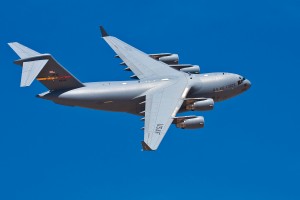
The 452nd Air Mobility Wing, headquartered at March Air Reserve Base, Riverside, Calif., brought the Boeing C-17 Globemaster III to El Centro.
The Black Daggers are the official U.S. Army Special Operations Command parachute demonstration team. With their distinctive red and black parachutes, they provided the air show spectators with a thrilling demonstration of the techniques used by the Army’s Special Forces personnel.
Among the vintage military aircraft demonstrated were a North American B-25 Mitchell medium bomber, a Grumman F6F Hellcat fighter and the last flying authentic Mitsubishi A6M Zero fighter. The Hellcat and the Zero performed a mock dogfight as part of their demonstration.
The final act of the show was the Blue Angels. Their presentation opened with a showcasing of the capabilities of “Fat Albert, the team’s Lockheed C-130T Hercules support aircraft. The all-Marine crew demonstrated the C-130’s short takeoff and landing capability and power back-up.
The Blue Angels took to the sky in their F/A-18C fighters, taking off in their traditional “Diamond” formation. At times, they fly as close as 18 inches apart. During their performance—with the four diamond and two solo pilots—they demonstrated maneuvers such as the Mirror Diamond, in which the No. 1 and No. 4 aircraft are inverted, an echelon formation and the Delta, consisting of all six aircraft. The two solo pilots performed maneuvers such as opposing horizontal rolls, high alpha passes and the solo high performance climb on takeoff.
For more information, go to [https://www.cnic.navy.mil/ElCentro/Airshow/index.htm].
- The U.S. Army Special Operations Command parachute demonstration team, the “Black Daggers,” highlighted some of the skills of the Army’s Airborne and Special Operations communities.
- Among the vintage warbirds at the El Centro Air Show was this pristine Grumman F6F Hellcat. The Hellcat was the premier U.S. Navy fighter in the Pacific Theatre of WWII.
- The A6M “Zero” was the Imperial Japanese Navy’s premier fighter at the start of WWII. Present at El Centro was the last flying genuine Zero in the world.
- Blue Angel No. 7, Lt. Ben Walborn, narrator (left) and Blue Angel No. 8, Lt. Amy Tomlinson, events coordinator (right) handled narration duties for show spectators.
- The Blue Angels support aircraft, a U.S. Marine Corps C-130T dubbed Fat Albert, kicked off the Blues Angels’ show.
- The Blue Angels demonstration pilots. Cmdr. Greg McWherter Flt Leader; Lt. Cmdr. Paul Brantuas; Maj. Chris Collins; Lt. Mark Swinger; Maj. Nathan Miller; Lt. Frank Weisser.
- The Blue Angels, in echelon formation, make a pass across show center.
- In their signature diamond formation, the Blue Angels perform a slow roll.
- Among the more unusual displays at El Centro was the Army Chopper, built by Orange County Choppers of the television show “American Choppers.”
- Attending the air show was Chief Petty Officer Sebastian Bach of the German Navy. Chief Bach is undergoing training on the Lockheed P-3 Orion with U.S. Navy Patrol Squadron 30 (VP-30) of NAS Jacksonville, Fla.












